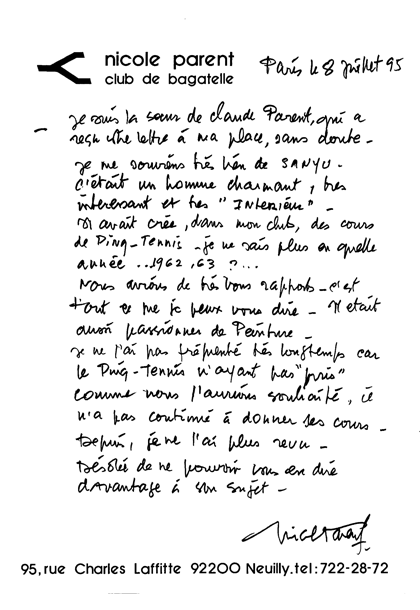如果常玉喜歡你,他會給你名片。然後當你發現所謂的名片其實是他在用過的地鐵票或公車票上優美地寫下名字與電話號碼時,他會看著你驚訝的表情得意竊笑。
常玉、丹尼爾、伊其理(法國雕塑家)、唐芬克(美國抽象畫家)、我、有時還有一些其他朋友,每年六月都會買一大堆鮮紅欲滴的櫻桃,然後到羅蘭加洛斯球場,在陽光下坐上好幾個小時,邊吃櫻桃邊看網球賽。多麼快樂美好的日子。
常玉很窮,但非常有創造力。他會請我們到他家,一起享用名叫「龍鬍子」的菜(水煮麵條加上很多辣醬)。因為缺乏食材,他就幫菜取上富有異國情調的名字,讓晚餐變得更有趣。常玉雖窮,但對藝術卻非常的熱愛與尊敬。有次我陪他和一位知名法國畫廊老闆見面,常玉不但拒絕賣畫給他,甚至不讓畫廊老闆踏入他的工作室看畫。他的理由很簡單:「我不喜歡他的長相」,還有「我才不要讓我的畫跟他住在一起」。
對於常玉的死,我有我的想法,也許有一天我會告訴你。但現在我只想說,當時我不在巴黎,他幫我照顧我的盆栽。我回來後,發現我和他的盆栽,都跟著他一起離開人世了。他走得並不孤單。
常玉,謝謝你的友誼。再見。
彭美拉.芙羅
1996年於法國巴黎
Memories of Sanyu
January 1959 will always remain a very special time in my pocket of memories. I had left England for Paris France to marry my wonderful French husband, Daniel. Meeting his varied and fascinating friends was very exciting!
I remember one stood out in particular. A quiet, middle-aged Chinese painter, “Sanyu”. When I got to know him better I discovered that he had a great sense of humor, was a fabulous cook, (he taught me how to prepare my first Chinese dish —— sweet and sour) and, like me, talked and played music to the green plants he loved to grow in his artist-studio-home, near Montparnasse.
Sanyu would distribute his visiting card to you, if he liked you, and then chuckle with delight when he saw your surprise at realising they were old, used metro/bus tickets that he had beautifully hand printed his name and phone number upon.
Sanyu, Daniel, Hiquily (a French sulpter), Don Fink (an American abstract painter), myself and sometimes other friends every June would buy kilos of bright red, juicy cherries and off we would go to “Roland-Garross” to spend many long hours sitting in the sun, munching on cherries and watching the tennis championships. Happy, joyful days!
Sanyu was very poor, but extremely inventive. He would invite us over to share a meal named “The Dragon’s Moustache” (boiled noodles with lots of hot chili sauce). For lack of other ingredients, he thought up exotic names to make his dinners more exciting ——57 and so they were! Although poor, his love and respect for his art were such that I was present at a meeting between Sanyu and a well-known French art gallery owner. When Sanyu refused not only to not sell paintings to this man, but not even let him enter his studio to look at his work. His explanation was simply “I don’t like his face” and “I don’t want my paintings to live with him”.
I have my own private ideas of Sanyu’s death, and maybe I’ll tell you one day. . . But for now, I just want to say that I was out of Paris when he died, and he was taking care of my plants. When I returned, I discovered that all of my plants, and his, had died with him. So he was not really alone.
Thank you, Sanyu, for your friendship. Bye Bye.
Pamela Forrest
Paris France 1996
